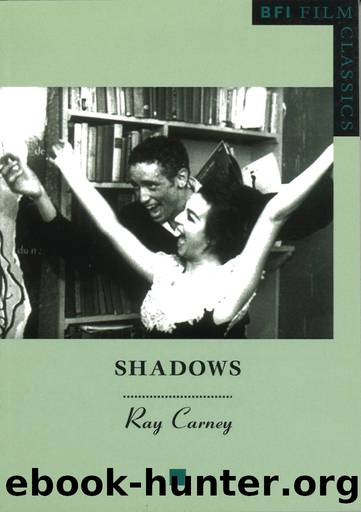Shadows by Raymond Carney

Author:Raymond Carney
Language: eng
Format: epub
Publisher: Bloomsbury Publishing
Published: 2019-01-15T00:00:00+00:00
High hopes: Cassavetes was in California working on Staccato and unable to attend Vogelâs Cinema 16 screenings in New York (Courtesy Gena Rowlands)
Hip and Square
The contrast between the two films on Vogelâs programme is illuminating. While Shadows uses figures like Lelia and Ben to interrogate the adequacy of Beat stances and claims of freedom, Pull My Daisy smugly, self-satisfyingly wallows in them. Frankâs film simply buys into Beat postures, while Cassavetesâ attempts to understand them and explore their emotional causes and consequences. Shadows is the rarest of works from that period â a film that analyses the fraudulence of Beat posturing, even as it appreciates why figures would want to protect themselves in this way. Imaginatively positioning itself half-inside, half-outside the Beat milieu, it reveals what is wrong with attempting to be hip and detached, while continuing to love the characters despite their flaws.
As is the case in so many Beat works (the films of Ron Rice and Ken Jacobs serving as relevant reference points), the actors in Pull My Daisy are in love with their own cuteness. They are ironic postmodernists before the fact â turning all of life into a jokesy âgoofâ or âlarkâ. Cassavetes, on the other hand, is a deadly serious film-maker (which doesnât prevent him from being hilarious as well). Pull My Daisy may be charming and fun, but it is ultimately a frivolous work, because it imagines creativity as off to the side of the âreal worldâ, something that you do on your days off â spouting doggerel and clowning around at home. For Cassavetes, the world is the place where you express your imagination. Leliaâs theatricality, like Mabelâs or Myrtleâs later, represents an enrichment of ordinary, everyday life, not an alternative to it or a vacation from it. Shadows may be funny but is never a joke. Lelia, Tony and Ben show us that our words and actions have serious consequences.
Film-making as Thinking
Although Cassavetes and Aurthur may have begun by simply attempting to make Shadows feel less episodic, the new scenes (and the respositionings of old ones) completely changed the film. A comparison of the two versions, to the extent we are able to induce what the earlier one looked like, provides a rare glimpse of Cassavetesâ mind at work. He appears to have studied his characters and their situations and changed his understanding of them. The first point to notice is that the additions are not about racial issues but charactersâ feelings. The drama moves inward. Characters are given depths of self-awareness that were largely absent from the first version.
Each of the characters is made more sympathetic by being given at least two new scenes which complicate our feelings about them. Hugh is no longer merely a failed musician who squabbles with his brother and manager, but is seen in caring encounters with Ben (in the rehearsal studio scene), Lelia (in the bus station and bedroom scenes) and Rupert (in the final Grand Central scene). Hughâs professional problem is also changed. In
Download
This site does not store any files on its server. We only index and link to content provided by other sites. Please contact the content providers to delete copyright contents if any and email us, we'll remove relevant links or contents immediately.
| Direction & Production | Reference |
The Kite Runner by Khaled Hosseini(5118)
Gerald's Game by Stephen King(4603)
Dialogue by Robert McKee(4350)
The Perils of Being Moderately Famous by Soha Ali Khan(4188)
The 101 Dalmatians by Dodie Smith(3474)
Story: Substance, Structure, Style and the Principles of Screenwriting by Robert McKee(3414)
The Pixar Touch by David A. Price(3386)
Confessions of a Video Vixen by Karrine Steffans(3266)
How Music Works by David Byrne(3218)
Harry Potter 4 - Harry Potter and The Goblet of Fire by J.K.Rowling(3026)
Fantastic Beasts: The Crimes of Grindelwald by J. K. Rowling(3023)
Slugfest by Reed Tucker(2963)
The Mental Game of Writing: How to Overcome Obstacles, Stay Creative and Productive, and Free Your Mind for Success by James Scott Bell(2870)
4 - Harry Potter and the Goblet of Fire by J.K. Rowling(2678)
Screenplay: The Foundations of Screenwriting by Syd Field(2596)
The Complete H. P. Lovecraft Reader by H.P. Lovecraft(2524)
Scandals of Classic Hollywood: Sex, Deviance, and Drama from the Golden Age of American Cinema by Anne Helen Petersen(2487)
Wildflower by Drew Barrymore(2463)
Robin by Dave Itzkoff(2406)
